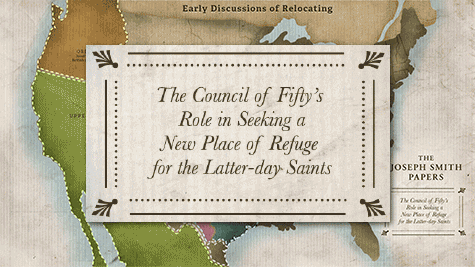Administrative Records: Council of Fifty, Minutes, Is Now Available
September 9, 2016 |
The Church Historian’s Press today announced the release of the latest volume of The Joseph Smith Papers. The new book, titled Administrative Records: Council of Fifty, Minutes, March 1844–January 1846, publishes the complete minutes of the meetings of the Council of Fifty held in Nauvoo, Illinois.
The Council of Fifty was a lesser-known organization created by Joseph Smith, founder and first president of The Church of Jesus Christ of Latter-day Saints, in March 1844, a few months before he was murdered. Council meetings resumed the following year under the direction of his successor, Brigham Young, and continued until shortly before the mass Mormon migration out of Illinois. A complete list of members of the council in Nauvoo can be found on the Joseph Smith Papers website.
The council was formed in part to plan for possible new settlements for church members. Members of the council also saw its formation as the beginning of the literal kingdom of God on earth.
The minutes reveal much about early Mormon thought on earthly and heavenly governments as council members wrestled with what it meant to establish the kingdom of God on earth and how that kingdom related to the church and to existing civil governments. Though council members generally used the term “theocracy” to describe the ideal form of government for the kingdom of God, their model also incorporated democratic elements, such as freedom of religion.
At the practical level, the Nauvoo-era Council of Fifty had perhaps three primary accomplishments. First, the council helped manage Joseph Smith’s 1844 presidential campaign. Second, the council provided a forum for making practical decisions about matters in Nauvoo, including construction of the Nauvoo temple. Third and most important, the council played a major role in exploring possible settlement sites and in planning the church’s migration to the American West (as illustrated in the maps below).
|
|
In assessing the new publication, historian Richard E. Bennett stated, “The Council of Fifty minutes are a treasure trove to anyone wanting to understand the last days of Joseph Smith, the martyrdom [of Joseph Smith], the last twenty months in Nauvoo, the revocation of the Nauvoo charter, the plans for exodus, and the apostates and renegades who inflicted so much damage upon the Saints. . . . They add a fabulous richness to our understanding. . . . The work of the editors places every matter of importance into excellent Mormon, American, and international historical context.”
The minutes of the Nauvoo-era Council of Fifty, which were inscribed by council scribe William Clayton in three small volumes, have never before been available for scholarly research. The minutes were brought across the plains by Brigham Young to the Salt Lake Valley. By the 1880s, the volumes were in the custody of the Office of the First Presidency, where they remained until the 21st century. In 2010, the First Presidency transferred the volumes to the Church History Library, after which Joseph Smith Papers scholars began preparing the records for publication.
While many of the actions taken by the council have been known through other documents, the minutes chronicle the deliberations that led to these decisions, providing an unparalleled view of decision making at the center of what participants viewed as the nascent kingdom of God on earth.
Elliott West, the prominent historian of the American West from the University of Arkansas, notes that the new volume from the Joseph Smith Papers “opens a wide window onto a previously shrouded, but extraordinarily revealing, part of Mormon leadership and life during what were arguably the most turbulent and treacherous months of the church’s history.” He adds, “Students of these pivotal events will be forever grateful for the insights and understanding they will find in these pages.”
Council of Fifty, Minutes, March 1844–January 1846, was edited by Matthew J. Grow, Ronald K. Esplin, Mark Ashurst-McGee, Gerrit J. Dirkmaat, and Jeffrey D. Mahas.



